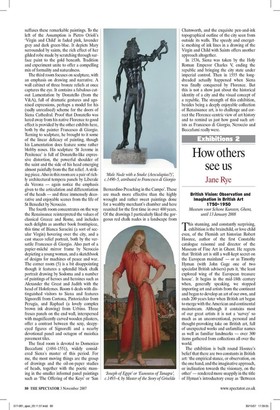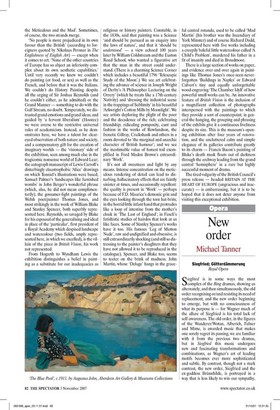How others see us
Jane Rye British Vision: Observation and Imagination in British Art 17501950 Museum voor Schone Kunsten, Ghent, until 13 January 2008 This stunning, and constantly surprising, exhibition is the brainchild, or love child even, of the Flemish art historian Robert Hoozee, author of the first Constable catalogue raisonne and director of the Museum of Fine Art in Ghent. He regrets that 'British art is still a well-kept secret on the European mainland' — or as Timothy Hyman (with John Gage one of two specialist British advisers) puts it, 'the least explored wing of the European treasure house'. It begins in the mid-18th century when, generally speaking, we stopped importing art and artists from the continent and began to develop an art of our own, and ends 200 years later when British art began to merge with the American and continental mainstream. Although it contains most of our great artists it is not a 'survey' so much as an unconventional, personal and thought-provoking take on British art, full of unexpected works and unfamiliar names as well as familiar landmarks — over 300 items gathered from collections all over the world.
The exhibition is built round Hoozee's belief that there are two constants in British art: `the empirical stance, or observation, on the one hand, and the imaginative approach, or inclination towards the visionary, on the other' — rendered more snappily in the title of Hyman's introductory essay as 'Between the Meticulous and the Mad'. Sometimes, of course, the two strands merge.
'No people is more prejudiced in its own favour than the British' (according to foreigners quoted by Nikolaus Pevsner in The Englishness of English Art) — except when it comes to art. 'None of the other countries of Europe has so abject an inferiority complex about its own aesthetic capabilities.' Until very recently we knew we couldn't do painting (or food, or sex) as well as the French, and before that it was the Italians. We couldn't do History Painting despite all the urging of Sir Joshua Reynolds (and he couldn't either, as he admitted) or the Grand Manner — something to do with the Gulf Stream, no doubt. Temperately, we distrusted grand emotions and grand ideas; and guided by 'a fervent liberalism' (Hoozee) we were averse to the restrictive universal rules of academicism. Instead, as he demonstrates here, we have a talent for cleareyed observation of both nature and society, and a compensatory gift for the creation of imaginary worlds — the 'visionary' side of the exhibition, seen among much else in the tragicomic nonsense world of Edward Lear; the autograph manuscript of Lewis Carroll's disturbingly claustrophobic 'Alice' drawings on which Tenniel's illustrations were based; Samuel Palmer's 'landscapes like furnished wombs' in John Berger's wonderful phrase (which, alas, he did not mean complimentarily); the gossamer-light paintings of the Welsh poet/painter Thomas Jones, and most strikingly in the work of William Blake and Stanley Spencer, both superbly represented here. Reynolds, so savaged by Blake for his espousal of the generalising and ideal in place of the 'particular', first president of a Royal Academy which despised landscape and watercolour (two fields, amply represented here, in which we excelled), is the villain of the piece in British Vision, his work not represented.
From Hogarth to Wyndham Lewis the exhibition distinguishes a belief in painting as a substitute for our inadequacies as religious or history painters. Constable, in the 1830s, said that painting was a Science 'and should be pursued as an enquiry into the laws of nature', and that it 'should be understood' — a view echoed 100 years later by William Coldstream and the Euston Road School, who wanted a figurative art that the man in the street could understand. (There is a charming Science Corner which includes a beautiful 1796 'Telescopic Study of the Moon'.) We see art celebrating the advance of science in Joseph Wright of Derby's 'A Philosopher Lecturing on the Orrery' (which he treats like a 17th-century Nativity) and 'dressing the industrial scene in the trappings of Sublimity' in his beautiful Arkwright's Cotton Mills by Moonlight'. We see artists deploring the plight of the poor and the decadence of the rich; celebrating friendship; ridiculing pomposity, cant and fashion in the works of Rowlandson, the frenetic Gillray, Cruikshank and others in a room devoted to 'the marginal and anarchic character of British humour'; and we see the inestimable value of honest toil exemplified in Ford Madox Brown's extraordinary 'Work'.
It's not all sweetness and light by any means. Intense concentration on the meticulous rendering of detail can lead to disturbing, hallucinatory effects that are faintly sinister at times, and occasionally repellent: the quality is present in 'Work' — perhaps because of ED. Maurice's demonic grin and the eyes looking through the torn hat-brim; in the horrid little infant hand that protrudes like a loop of intestine from the mother's cloak in 'The Last of England'; in Fuseli's fetishistic studies of hairdos that look at us like faces. Some of Stanley Spencer's works have it too. His famous 'Leg of Mutton Nude', raw and undignified and obsessive, is still extraordinarily shocking (and still so distressing to the painter's daughters that they have not allowed it to be reproduced in the catalogue). Spencer, and Blake too, seems to teeter on the brink of madness. John Martin, whose 'Deluge' hangs in the graceful central rotunda, used to be called 'Mad Martin' (his brother was the Incendiary of York Minster) and of course Richard Dadd, represented here with five works including a creepily baleful little watercolour called 'A Child's Problem', murdered his father in a fit of insanity and died in Broadmoor.
There is a large section of works on paper, and evidence over and over again in paintings like Thomas Jones's once-seen-neverforgotten 'Buildings in Naples' or Edward Calvert's tiny and equally unforgettable wood-engraving 'The Chamber Idyll' of how powerful small works can be. An innovative feature of British Vision is the inclusion of a magnificent collection of photographs interspersed with the paintings to which they provide a sort of counterpoint; in general the hanging, the grouping and phrasing of the exhibits give it a continuous liveliness despite its size. This is the museum's opening exhibition after four years of renovation, and the uncluttered calm and simple elegance of its galleries contribute greatly to its charm — Francis Bacon's painting of Blake's death mask floats out of darkness through the archway leading from the grand central 'hemisphere' in a rare but highly successful moment of drama.
The tired vulgarity of the British Council's press release — headed BRITAIN AT THE HEART OF EUROPE (ungracious and inaccurate) — is embarrassing, but it is to be hoped that it does not deter anyone from visiting this exceptional exhibition.













































































 Previous page
Previous page